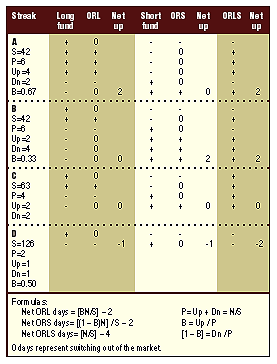TRADING TECHNIQUES
A Mutual Fund Trading Method, Part II
Combining Long And Short Funds
by Norman J. Brown
Obtain better profits and reduce your risks by using this method to select mutual funds for trading.
In the June 2003 issue of STOCKS & COMMODITIES, in my article "A Mutual Fund Trading Method," we saw some excellent trading results using just one mutual fund. The method I used was a one-day, one-fund daily ranking that determined buy and sell entry points. When not invested in the ranked fund, you were either out of the market or in a money market fund until another buy signal was triggered.
This time, I'll use the previous one-day, one-fund daily ranking (OR) and expand it to allow replacing the money market fund with a "short" (beta = -1) version of the basic "long" fund. I will refer to the long process as "Orl," investing short (only) will be "Ors," and the combination will be "Orls."
In order to synthesize Ors funds that did not exist during the FastTrack database period used, the short funds were created from the various long funds studied by taking the daily inverse return in FastTrack (the Dos version) by a technique explained in the sidebar, "Implementing Orls into FastTrack." It can also be implemented in Excel and then be imported into FastTrack, if so desired. Today, there are a variety of such inverse funds available from Rydex, Potomac, and Profunds that allow the rapid trading essential for OR high switching-rates.
DEVELOPMENT OF FORMULA
Previously, I developed a simple formula for calculating net up days for buy and hold (BH) and for Orl:
BH= N(2B - 1) (Equation 1) Orl = B*N - 2S (2)
How much does Orl exceed BH (remember this is in net up days)?
Orl - BH = N*(1 - B) - 2S (3)
This is an insightful equation, since it not only determines the amount that Orl will exceed BH (or just as well might underperform) but can be recognized as the Ors version of equation 2 when you replace B with (1 ? B), which is, in effect, the OR switching of a "complementary" fund that will be described as a "short" or Ors switched mutual fund. Equation 4 can then be established as follows:
Orl - BH = Ors (4)
This simple expression is the key, since it suggests that if Orl is to exceed BH, then Ors must be positive. If Ors is positive, why not play it by investing in an appropriate short fund in place of going into a money market fund during the sell period, creating a long/short trading approach designated Orls:

FIGURE 1: PERFORMANCE FOR VARIOUS STREAKS. Up days are identified by a plus sign and down days by a minus sign. Streaks are identified by a series of plus days followed by some minus days.
Orls = Orl + Ors = [B*N - 2S] + [(1 - B)*N - 2S] = N - 4S (5)
...Continued in the July 2003 issue of Technical Analysis of
STOCKS & COMMODITIES
Excerpted from an article originally published in the July 2003 issue of Technical Analysis of STOCKS & COMMODITIES magazine. All rights reserved. © Copyright 2003, Technical Analysis, Inc.